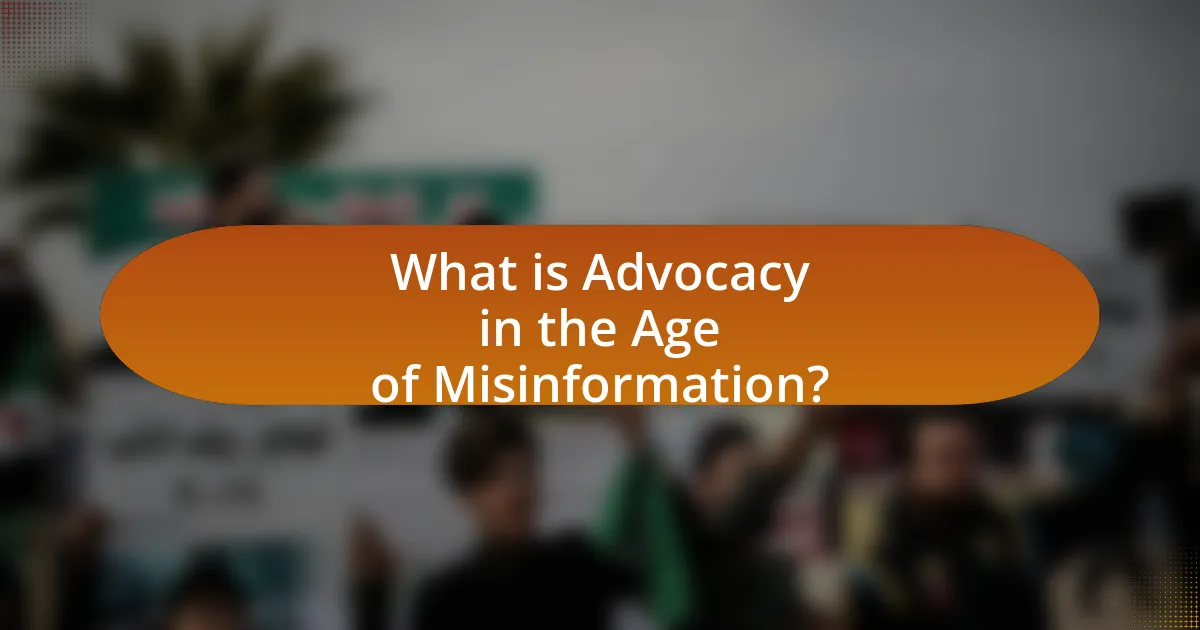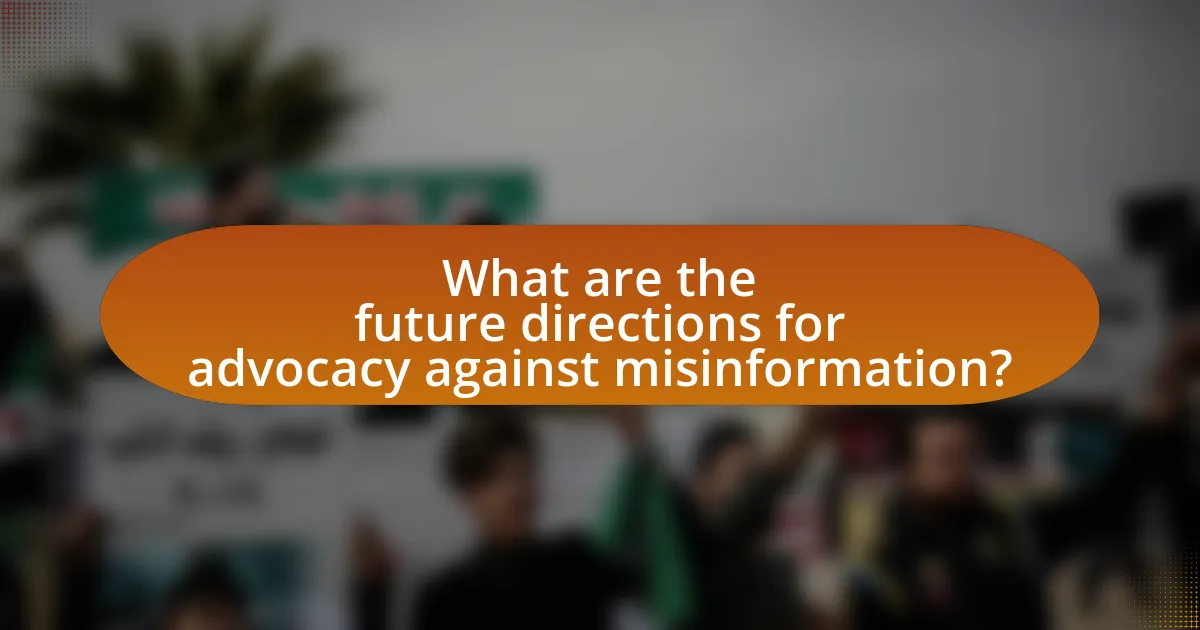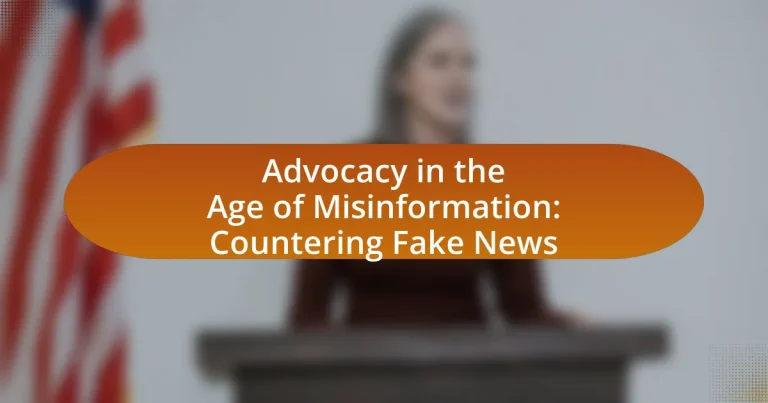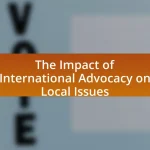Advocacy in the age of misinformation focuses on promoting accurate information and combating false narratives to safeguard public discourse and democracy. The article examines the evolution of misinformation in the digital age, its characteristics, and its detrimental impact on public perception and trust. It highlights the importance of advocacy in countering fake news through media literacy, fact-checking, and responsible communication, while also addressing the challenges advocates face in reaching diverse audiences. Furthermore, it explores effective strategies for combating misinformation, the role of technology, and the significance of collaboration among organizations to enhance advocacy efforts.

What is Advocacy in the Age of Misinformation?
Advocacy in the age of misinformation involves promoting accurate information and combating false narratives to protect public discourse and democracy. This form of advocacy is crucial as misinformation can distort perceptions, influence public opinion, and undermine trust in institutions. For instance, studies show that misinformation spreads six times faster than factual information on social media platforms, highlighting the urgent need for advocacy efforts that focus on media literacy, fact-checking, and responsible communication. Organizations like the International Fact-Checking Network actively work to counter misinformation by verifying claims and educating the public, demonstrating the effectiveness of advocacy in fostering informed communities.
How has misinformation evolved in the digital age?
Misinformation has evolved in the digital age through rapid dissemination via social media platforms and the internet, significantly increasing its reach and impact. The rise of user-generated content and algorithms that prioritize engagement over accuracy have facilitated the spread of false information, making it more challenging to distinguish credible sources from unreliable ones. For instance, a study by the Pew Research Center in 2020 found that 53% of Americans reported encountering made-up news, highlighting the prevalence of misinformation in online spaces. Additionally, the ability to create and share content anonymously has led to the proliferation of conspiracy theories and misleading narratives, further complicating efforts to combat misinformation.
What are the key characteristics of misinformation today?
The key characteristics of misinformation today include its rapid spread, emotional appeal, and lack of credible sources. Misinformation often circulates quickly through social media platforms, reaching large audiences in a short time frame, as evidenced by studies showing that false information spreads six times faster than true information on Twitter. Additionally, misinformation frequently evokes strong emotional responses, which can lead to increased sharing among users. Lastly, it typically lacks verification from reliable sources, making it difficult for individuals to discern its accuracy, as highlighted by research from the Pew Research Center indicating that many people struggle to identify credible news sources.
How does misinformation impact public perception and trust?
Misinformation significantly undermines public perception and trust by distorting facts and creating confusion. When individuals encounter false information, they may develop skewed beliefs about important issues, leading to a lack of confidence in credible sources. Research indicates that exposure to misinformation can result in a 70% increase in the likelihood of individuals doubting the reliability of news outlets, as shown in a study published in the journal “Science Advances” by Lewandowsky et al. (2012). This erosion of trust can have far-reaching consequences, including decreased civic engagement and increased polarization within society.
Why is advocacy important in countering fake news?
Advocacy is crucial in countering fake news because it promotes media literacy and critical thinking among the public. By educating individuals on how to identify credible sources and discern misinformation, advocacy efforts empower people to make informed decisions. Research indicates that media literacy programs can significantly reduce the susceptibility to fake news, as demonstrated by a study published in the Journal of Media Literacy Education, which found that participants who underwent media literacy training were 30% less likely to believe false information. Thus, advocacy plays a vital role in fostering a well-informed society capable of resisting the spread of misinformation.
What role do advocates play in promoting accurate information?
Advocates play a crucial role in promoting accurate information by actively disseminating verified facts and challenging misinformation. They engage in public education campaigns, utilize social media platforms, and collaborate with fact-checking organizations to ensure that the public receives reliable data. For instance, organizations like the Poynter Institute and the International Fact-Checking Network work with advocates to provide resources and training on identifying false information. This collaborative effort enhances the overall media literacy of the community, empowering individuals to discern credible sources from misleading ones.
How can advocacy influence policy and media practices?
Advocacy can influence policy and media practices by mobilizing public opinion and creating pressure for change. Through campaigns, advocacy groups can raise awareness about issues, leading to increased media coverage and prompting policymakers to address concerns. For instance, the advocacy efforts surrounding climate change have resulted in significant policy shifts, such as the Paris Agreement, which was influenced by widespread public demand for action. Additionally, advocacy organizations often provide research and data that inform media narratives, helping to shape the discourse around critical issues and counter misinformation.
What strategies are effective in combating misinformation?
Effective strategies in combating misinformation include promoting media literacy, fact-checking, and fostering transparency in information sources. Media literacy education equips individuals with critical thinking skills to evaluate the credibility of information, as evidenced by studies showing that media literacy programs can significantly reduce susceptibility to misinformation. Fact-checking initiatives, such as those by organizations like Snopes and FactCheck.org, provide verified information and debunk false claims, thereby reducing the spread of inaccuracies. Additionally, encouraging transparency from information sources, including social media platforms, helps users identify reliable content, as demonstrated by research indicating that transparency can enhance trust and reduce the impact of misinformation.
How can fact-checking organizations contribute to advocacy?
Fact-checking organizations contribute to advocacy by providing accurate information that counters misinformation, thereby empowering advocates to make informed decisions and engage effectively with their audiences. These organizations analyze claims made in public discourse, verify their accuracy, and disseminate findings, which helps to build credibility and trust in advocacy efforts. For instance, during elections, fact-checkers have been shown to reduce the spread of false information, as evidenced by a study from the Duke Reporters’ Lab, which found that fact-checking can significantly influence public perception and behavior. By ensuring that advocates have access to verified data, fact-checking organizations enhance the overall quality of public debate and support the integrity of advocacy initiatives.
What educational initiatives can empower individuals against fake news?
Educational initiatives that can empower individuals against fake news include media literacy programs, critical thinking workshops, and fact-checking resources. Media literacy programs teach individuals how to analyze and evaluate information sources, helping them discern credible news from misinformation. Critical thinking workshops enhance analytical skills, enabling participants to question the validity of information and recognize biases. Fact-checking resources, such as websites and tools, provide users with the means to verify claims and assess the accuracy of news stories. Research indicates that individuals who engage in these educational initiatives are better equipped to identify and resist fake news, as evidenced by studies showing improved discernment in media consumption among participants in such programs.

What are the challenges faced by advocates in this context?
Advocates face significant challenges in countering misinformation, primarily due to the rapid spread of false information through social media platforms. This environment complicates efforts to educate the public, as misinformation often outpaces factual corrections, leading to widespread misconceptions. Additionally, advocates encounter difficulties in establishing credibility, as the prevalence of fake news can undermine trust in legitimate sources. Research indicates that misinformation can have lasting effects on public perception, making it harder for advocates to shift narratives once falsehoods take root. Furthermore, advocates must navigate the emotional responses elicited by misinformation, which can polarize audiences and hinder constructive dialogue.
How do social media platforms contribute to the spread of misinformation?
Social media platforms contribute to the spread of misinformation by enabling rapid dissemination of unverified content to vast audiences. The algorithms used by these platforms often prioritize engagement over accuracy, leading to sensational or misleading information being shared more widely than factual reporting. For instance, a study by the Massachusetts Institute of Technology found that false news stories are 70% more likely to be retweeted than true stories, highlighting the platforms’ role in amplifying misinformation. Additionally, the lack of stringent fact-checking mechanisms allows false narratives to proliferate unchecked, further exacerbating the issue.
What responsibilities do social media companies have in curbing fake news?
Social media companies have a responsibility to implement measures that effectively identify, reduce, and prevent the spread of fake news on their platforms. This includes employing advanced algorithms and artificial intelligence to detect misinformation, providing users with fact-checking resources, and promoting media literacy initiatives. For instance, Facebook has partnered with independent fact-checkers to assess the accuracy of content, which has led to a reduction in the visibility of false information by 80% in some cases. Additionally, social media companies must establish clear policies for content moderation and transparency regarding their actions against misinformation, as outlined in the European Union’s Digital Services Act, which mandates accountability for online platforms in managing harmful content.
How can advocates navigate the complexities of platform algorithms?
Advocates can navigate the complexities of platform algorithms by employing data-driven strategies that enhance visibility and engagement. Understanding how algorithms prioritize content based on user interaction, relevance, and recency allows advocates to tailor their messaging effectively. For instance, utilizing analytics tools to track engagement metrics can inform advocates about which types of content resonate most with their audience, enabling them to optimize their outreach efforts. Additionally, collaborating with tech experts to comprehend algorithm changes and trends can further empower advocates to adapt their strategies in real-time, ensuring their messages reach the intended audience amidst the noise of misinformation.
What obstacles do advocates encounter in reaching diverse audiences?
Advocates encounter several obstacles in reaching diverse audiences, including language barriers, cultural differences, and varying levels of access to technology. Language barriers hinder effective communication, as advocates may struggle to convey their messages to non-native speakers. Cultural differences can lead to misunderstandings or misinterpretations of the advocacy message, making it less relatable or relevant to certain groups. Additionally, varying levels of access to technology can limit the ability of some audiences to receive information, particularly in underserved communities where internet access may be restricted. These factors collectively impede the effectiveness of advocacy efforts aimed at diverse populations.
How can cultural differences affect the reception of advocacy messages?
Cultural differences significantly affect the reception of advocacy messages by influencing how individuals interpret and respond to information. For instance, collectivist cultures may prioritize group harmony and consensus, leading them to be more receptive to messages that emphasize community benefits, while individualistic cultures may respond better to messages highlighting personal freedom and individual rights. Research indicates that cultural values shape communication styles, with high-context cultures relying on implicit messages and relationships, whereas low-context cultures favor direct and explicit communication. This divergence can lead to misunderstandings or misinterpretations of advocacy messages, ultimately impacting their effectiveness.
What strategies can be employed to engage marginalized communities?
To engage marginalized communities, strategies such as building trust through consistent communication, involving community leaders in decision-making, and utilizing culturally relevant messaging can be employed. Research indicates that trust is crucial; for instance, a study by the Pew Research Center found that marginalized groups are more likely to engage when they feel their voices are heard and respected. Additionally, participatory approaches that include community input in the design and implementation of programs have proven effective, as evidenced by successful initiatives in public health that increased participation rates among underrepresented populations.

What are the future directions for advocacy against misinformation?
Future directions for advocacy against misinformation include enhancing digital literacy, promoting fact-checking initiatives, and fostering collaboration among tech companies, governments, and civil society. Digital literacy programs aim to equip individuals with critical thinking skills necessary to identify false information, as studies show that informed users are less likely to share misinformation. Fact-checking initiatives, such as those by organizations like Snopes and FactCheck.org, provide reliable resources for verifying claims, which can significantly reduce the spread of false narratives. Additionally, collaboration among stakeholders can lead to the development of more effective policies and technologies to combat misinformation, as evidenced by successful partnerships in various countries that have led to measurable decreases in misinformation dissemination.
How can technology be leveraged to enhance advocacy efforts?
Technology can be leveraged to enhance advocacy efforts by utilizing digital platforms for outreach, engagement, and information dissemination. Social media allows advocates to reach a broader audience quickly, facilitating real-time communication and mobilization around issues. For instance, campaigns like the #MeToo movement effectively used Twitter to raise awareness and foster community support, demonstrating the power of technology in amplifying voices. Additionally, data analytics can help organizations understand public sentiment and tailor their messages accordingly, ensuring that advocacy efforts resonate with target demographics. Research indicates that 70% of people are more likely to support a cause when they see it discussed on social media, highlighting the effectiveness of technology in driving advocacy initiatives.
What role do artificial intelligence and machine learning play in combating misinformation?
Artificial intelligence and machine learning play a crucial role in combating misinformation by enabling the automated detection and analysis of false information across various platforms. These technologies utilize algorithms that can analyze vast amounts of data, identify patterns, and flag content that is likely to be misleading or false. For instance, machine learning models can be trained on labeled datasets of true and false information, allowing them to recognize similar patterns in new content. Research from MIT demonstrated that AI can identify misinformation with up to 95% accuracy, showcasing its effectiveness in real-time monitoring and response. Additionally, AI-driven tools can assist in fact-checking by cross-referencing claims with verified sources, thereby enhancing the credibility of information disseminated online.
How can data analytics improve the effectiveness of advocacy campaigns?
Data analytics can significantly enhance the effectiveness of advocacy campaigns by enabling targeted messaging and strategic decision-making. By analyzing demographic data, social media trends, and engagement metrics, advocacy organizations can identify key audiences and tailor their messages to resonate with specific groups. For instance, a study by the Pew Research Center found that campaigns utilizing data-driven strategies saw a 30% increase in engagement compared to those that did not. This targeted approach not only improves outreach but also optimizes resource allocation, ensuring that efforts are concentrated where they are most likely to yield results.
What best practices should advocates adopt moving forward?
Advocates should adopt evidence-based communication strategies moving forward. This involves utilizing verified data and credible sources to counter misinformation effectively. For instance, a study by the Pew Research Center found that fact-checking and providing context significantly reduce the spread of false information. Additionally, advocates should engage in active listening and dialogue with their audience to understand concerns and tailor their messages accordingly. This approach fosters trust and encourages informed discussions, as demonstrated by successful campaigns that prioritize transparency and community involvement.
How can collaboration among organizations strengthen advocacy efforts?
Collaboration among organizations can strengthen advocacy efforts by pooling resources, expertise, and networks to create a unified front against misinformation. When multiple organizations work together, they can amplify their messages, reach broader audiences, and enhance credibility through collective authority. For instance, a study by the Pew Research Center found that collaborative campaigns can increase public engagement by up to 50%, demonstrating the effectiveness of joint efforts in advocacy. Additionally, partnerships allow for sharing of best practices and strategies, which can lead to more effective counter-narratives against fake news.
What are the key takeaways for individuals looking to advocate against misinformation?
Individuals looking to advocate against misinformation should prioritize fact-checking, promoting media literacy, and fostering open dialogue. Fact-checking involves verifying information through credible sources, which helps to debunk false claims and build trust in accurate reporting. Promoting media literacy equips individuals with the skills to critically evaluate information, enabling them to discern credible news from misinformation. Fostering open dialogue encourages discussions about misinformation, allowing communities to share knowledge and strategies for combating false narratives. These approaches are supported by studies indicating that media literacy programs can significantly reduce susceptibility to misinformation, as evidenced by research from the Stanford History Education Group, which found that students who received media literacy training were better at identifying misinformation.


